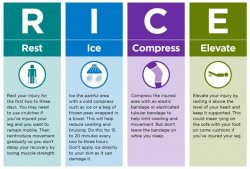Strains and Sprains: Things You Should Know
By: Alexis Sell, MSN, APN
Posted in: Health Tips, Injuries

A common ailment that many people face at least once in their lifetime is a strain or a sprain. A strain involves injury to a muscle, while a sprain involves injury to a joint.
Strains are Common
Common sites for strains include:
- Back
- Hamstring (behind your thigh)
- Forearm
- Hands
Sprains are Common, Too!
Common sites for sprains include:
- Ankle
- Knee,
- Wrist
- Fingers
These injuries can be caused by direct trauma to the affected area, falls, twisting/pulling movements, lifting heavy objects and with overuse or repetitive movements.
Symptoms
Symptoms of both strains and sprains can include pain, swelling, bruising, tenderness to touch and limited movement of the injured area. Strains can also cause some muscle weakness or spasms. With a sprain, you may even hear or feel a popping sensation at the time of injury. Individuals who play sports or are very physically active such as college students are more prone to strains and sprains than someone who has a sedentary lifestyle.
RICE
The most highly recommended way to treat sprains and strains is known as RICE therapy.
RICE stands for Rest, Ice, Compression, and Elevation.
- Rest the injured area as much as possible, taking frequent breaks when performing physical activities.
- Apply ice as soon as the injury occurs to minimize swelling and decrease your discomfort. Ice is advised for 10 minutes three times daily. Approximately 72 hours after the injury occurs, applying heat (not on bare skin) for 10 minutes three times daily instead of ice may be more beneficial.
- In addition, a compression wrap (i.e. an ACE bandage) for the first few days may provide comfort; just make sure it is not too tight to cause numbness or tingling.
- Finally, elevating the affected area throughout the day will also help to decrease swelling.
Should I Get It Looked At?
It is recommended to see a health care provider if you cannot bear any weight (limping is okay), if any of your symptoms are severe, if any visible deformities are present, if you experience numbness or redness spreading out from the injury or if you are concerned for any other reason that a fracture or dislocation might be present.
Over the counter medications, such as ibuprofen, naproxen, or acetaminophen (Tylenol) can be used as directed on the package and should be taken with food. When your symptoms fully resolve (improvement should be experienced by one week post-injury), you can return to your normal physical activities but at a gradual pace in order to prevent re-injury.
